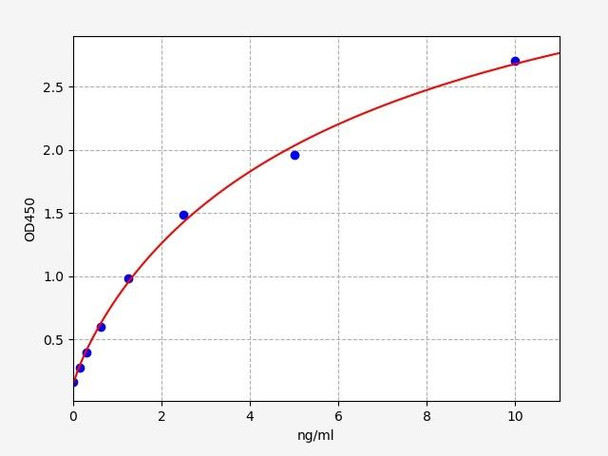Human PEBP1 / Phosphatidylethanolamine-binding protein 1 ELISA Kit
- SKU:
- HUFI01169
- Product Type:
- ELISA Kit
- Size:
- 96 Assays
- Uniprot:
- P30086
- Sensitivity:
- 0.094ng/ml
- Range:
- 0.156-10ng/ml
- ELISA Type:
- Sandwich
- Synonyms:
- PEBP1, HCNPpp, Neuropolypeptide h3, PBP, PEBP-1, HCNP, hippocampal cholinergic neurostimulating peptide, Neuropolypeptide h3, phosphatidylethanolamine binding protein 1, prostatic binding protein, Prostatic-binding protein, Raf kinase inhibitory prot
- Reactivity:
- Human
- Research Area:
- Cell Biology
Description
Human PEBP1/Phosphatidylethanolamine-binding protein 1 ELISA Kit
The Human PEBP1 (Phosphatidylethanolamine Binding Protein 1) ELISA Kit is specifically designed for the accurate detection of PEBP1 levels in human serum, plasma, and cell culture supernatants. This kit offers high sensitivity and specificity, ensuring dependable and repeatable results for a variety of research applications.PEBP1 is a critical protein that binds to phospholipids and plays a key role in various cellular processes, including cell proliferation, apoptosis, and signal transduction.
Dysregulation of PEBP1 has been implicated in diseases such as cancer, Alzheimer's, and inflammatory disorders, making it a valuable biomarker for understanding disease mechanisms and potential therapeutic targets.Overall, the Human PEBP1 ELISA Kit provides researchers with a reliable tool for studying the role of PEBP1 in health and disease, leading to a better understanding of its functional significance and potential clinical applications.
| Product Name: | Human PEBP1 / Phosphatidylethanolamine-binding protein 1 ELISA Kit |
| Product Code: | HUFI01169 |
| Size: | 96 Assays |
| Alias: | PEBP1, HCNPpp, Neuropolypeptide h3, PBP, PEBP-1, HCNP, hippocampal cholinergic neurostimulating peptide, Neuropolypeptide h3, phosphatidylethanolamine binding protein 1, prostatic binding protein, Prostatic-binding protein, Raf kinase inhibitory protein, RKIPRaf kinase inhibitor protein |
| Detection method: | Sandwich ELISA, Double Antibody |
| Application: | This immunoassay kit allows for the in vitro quantitative determination of Human PEBP1 concentrations in serum plasma and other biological fluids. |
| Sensitivity: | 0.094ng/ml |
| Range: | 0.156-10ng/ml |
| Storage: | 4°C for 6 months |
| Note: | For Research Use Only |
| Recovery: | Matrices listed below were spiked with certain level of Human PEBP1 and the recovery rates were calculated by comparing the measured value to the expected amount of Human PEBP1 in samples. | ||||||||||||||||
| |||||||||||||||||
| Linearity: | The linearity of the kit was assayed by testing samples spiked with appropriate concentration of Human PEBP1 and their serial dilutions. The results were demonstrated by the percentage of calculated concentration to the expected. | ||||||||||||||||
| |||||||||||||||||
| CV(%): | Intra-Assay: CV<8% Inter-Assay: CV<10% |
| Component | Quantity | Storage |
| ELISA Microplate (Dismountable) | 8×12 strips | 4°C for 6 months |
| Lyophilized Standard | 2 | 4°C/-20°C |
| Sample/Standard Dilution Buffer | 20ml | 4°C |
| Biotin-labeled Antibody(Concentrated) | 120ul | 4°C (Protect from light) |
| Antibody Dilution Buffer | 10ml | 4°C |
| HRP-Streptavidin Conjugate(SABC) | 120ul | 4°C (Protect from light) |
| SABC Dilution Buffer | 10ml | 4°C |
| TMB Substrate | 10ml | 4°C (Protect from light) |
| Stop Solution | 10ml | 4°C |
| Wash Buffer(25X) | 30ml | 4°C |
| Plate Sealer | 5 | - |
Other materials and equipment required:
- Microplate reader with 450 nm wavelength filter
- Multichannel Pipette, Pipette, microcentrifuge tubes and disposable pipette tips
- Incubator
- Deionized or distilled water
- Absorbent paper
- Buffer resevoir
| Uniprot | P30086 |
| UniProt Protein Function: | RKIP: a metastasis suppressor that regulates extracellular matrix remodeling and tumor survival. Binds to and inhibits Raf-1. Phosphorylation by classic and atypical but not novel PKC isoforms dissociates this complex, relieving inhibition of the Raf/MAP kinase signaling cascade. Binds ATP, opioids and phosphatidylethanolamine. Has lower affinity for phosphatidylinositol and phosphatidylcholine. Serine protease inhibitor which inhibits thrombin, neuropsin and chymotrypsin but not trypsin, tissue type plasminogen activator and elastase Inhibits the kinase activity of RAF1 by inhibiting its activation and by dissociating the RAF1/MEK complex and acting as a competitive inhibitor of MEK phosphorylation. Cleaved into hippocampal cholinergic neurostimulating peptide (HCMP) that appears to be involved in the function of the presynaptic cholinergic neurons of the central nervous system. HCNP increases the production of choline acetyltransferase but not acetylcholinesterase. Expressed in brain. Increased expression in aged senescence-accelerated mice. |
| UniProt Protein Details: | Protein type:Lipid-binding; Protein kinase, regulatory subunit Chromosomal Location of Human Ortholog: 12q24.23 Cellular Component: cytosol; nucleus Molecular Function:enzyme binding; phosphatidylethanolamine binding; protein binding; protein kinase binding Biological Process: MAPKKK cascade |
| NCBI Summary: | This gene encodes a member of the phosphatidylethanolamine-binding family of proteins and has been shown to modulate multiple signaling pathways, including the MAP kinase (MAPK), NF-kappa B, and glycogen synthase kinase-3 (GSK-3) signaling pathways. The encoded protein can be further processed to form a smaller cleavage product, hippocampal cholinergic neurostimulating peptide (HCNP), which may be involved in neural development. This gene has been implicated in numerous human cancers and may act as a metastasis suppressor gene. Multiple pseudogenes of this gene have been identified in the genome. [provided by RefSeq, Jul 2015] |
| UniProt Code: | P30086 |
| NCBI GenInfo Identifier: | 1352726 |
| NCBI Gene ID: | 5037 |
| NCBI Accession: | P30086.3 |
| UniProt Secondary Accession: | P30086,B2R4S1, |
| UniProt Related Accession: | P30086 |
| Molecular Weight: | 21,057 Da |
| NCBI Full Name: | Phosphatidylethanolamine-binding protein 1 |
| NCBI Synonym Full Names: | phosphatidylethanolamine binding protein 1 |
| NCBI Official Symbol: | PEBP1 |
| NCBI Official Synonym Symbols: | PBP; HCNP; PEBP; RKIP; HCNPpp; PEBP-1; HEL-210; HEL-S-34; HEL-S-96 |
| NCBI Protein Information: | phosphatidylethanolamine-binding protein 1 |
| UniProt Protein Name: | Phosphatidylethanolamine-binding protein 1 |
| UniProt Synonym Protein Names: | HCNPpp; Neuropolypeptide h3; Prostatic-binding protein; Raf kinase inhibitor protein; RKIP |
| Protein Family: | Phosphatidylethanolamine-binding protein |
| UniProt Gene Name: | PEBP1 |
| UniProt Entry Name: | PEBP1_HUMAN |
*Note: Protocols are specific to each batch/lot. For the correct instructions please follow the protocol included in your kit.
Before adding to wells, equilibrate the SABC working solution and TMB substrate for at least 30 min at 37°C. When diluting samples and reagents, they must be mixed completely and evenly. It is recommended to plot a standard curve for each test.
| Step | Protocol |
| 1. | Set standard, test sample and control (zero) wells on the pre-coated plate respectively, and then, record their positions. It is recommended to measure each standard and sample in duplicate. Wash plate 2 times before adding standard, sample and control (zero) wells! |
| 2. | Aliquot 0.1ml standard solutions into the standard wells. |
| 3. | Add 0.1 ml of Sample / Standard dilution buffer into the control (zero) well. |
| 4. | Add 0.1 ml of properly diluted sample ( Human serum, plasma, tissue homogenates and other biological fluids.) into test sample wells. |
| 5. | Seal the plate with a cover and incubate at 37 °C for 90 min. |
| 6. | Remove the cover and discard the plate content, clap the plate on the absorbent filter papers or other absorbent material. Do NOT let the wells completely dry at any time. Wash plate X2. |
| 7. | Add 0.1 ml of Biotin- detection antibody working solution into the above wells (standard, test sample & zero wells). Add the solution at the bottom of each well without touching the side wall. |
| 8. | Seal the plate with a cover and incubate at 37°C for 60 min. |
| 9. | Remove the cover, and wash plate 3 times with Wash buffer. Let wash buffer rest in wells for 1 min between each wash. |
| 10. | Add 0.1 ml of SABC working solution into each well, cover the plate and incubate at 37°C for 30 min. |
| 11. | Remove the cover and wash plate 5 times with Wash buffer, and each time let the wash buffer stay in the wells for 1-2 min. |
| 12. | Add 90 µl of TMB substrate into each well, cover the plate and incubate at 37°C in dark within 10-20 min. (Note: This incubation time is for reference use only, the optimal time should be determined by end user.) And the shades of blue can be seen in the first 3-4 wells (with most concentrated standard solutions), the other wells show no obvious color. |
| 13. | Add 50 µl of Stop solution into each well and mix thoroughly. The color changes into yellow immediately. |
| 14. | Read the O.D. absorbance at 450 nm in a microplate reader immediately after adding the stop solution. |
When carrying out an ELISA assay it is important to prepare your samples in order to achieve the best possible results. Below we have a list of procedures for the preparation of samples for different sample types.
| Sample Type | Protocol |
| Serum | If using serum separator tubes, allow samples to clot for 30 minutes at room temperature. Centrifuge for 10 minutes at 1,000x g. Collect the serum fraction and assay promptly or aliquot and store the samples at -80°C. Avoid multiple freeze-thaw cycles. If serum separator tubes are not being used, allow samples to clot overnight at 2-8°C. Centrifuge for 10 minutes at 1,000x g. Remove serum and assay promptly or aliquot and store the samples at -80°C. Avoid multiple freeze-thaw cycles. |
| Plasma | Collect plasma using EDTA or heparin as an anticoagulant. Centrifuge samples at 4°C for 15 mins at 1000 × g within 30 mins of collection. Collect the plasma fraction and assay promptly or aliquot and store the samples at -80°C. Avoid multiple freeze-thaw cycles. Note: Over haemolysed samples are not suitable for use with this kit. |
| Urine & Cerebrospinal Fluid | Collect the urine (mid-stream) in a sterile container, centrifuge for 20 mins at 2000-3000 rpm. Remove supernatant and assay immediately. If any precipitation is detected, repeat the centrifugation step. A similar protocol can be used for cerebrospinal fluid. |
| Cell culture supernatant | Collect the cell culture media by pipette, followed by centrifugation at 4°C for 20 mins at 1500 rpm. Collect the clear supernatant and assay immediately. |
| Cell lysates | Solubilize cells in lysis buffer and allow to sit on ice for 30 minutes. Centrifuge tubes at 14,000 x g for 5 minutes to remove insoluble material. Aliquot the supernatant into a new tube and discard the remaining whole cell extract. Quantify total protein concentration using a total protein assay. Assay immediately or aliquot and store at ≤ -20 °C. |
| Tissue homogenates | The preparation of tissue homogenates will vary depending upon tissue type. Rinse tissue with 1X PBS to remove excess blood & homogenize in 20ml of 1X PBS (including protease inhibitors) and store overnight at ≤ -20°C. Two freeze-thaw cycles are required to break the cell membranes. To further disrupt the cell membranes you can sonicate the samples. Centrifuge homogenates for 5 mins at 5000xg. Remove the supernatant and assay immediately or aliquot and store at -20°C or -80°C. |
| Tissue lysates | Rinse tissue with PBS, cut into 1-2 mm pieces, and homogenize with a tissue homogenizer in PBS. Add an equal volume of RIPA buffer containing protease inhibitors and lyse tissues at room temperature for 30 minutes with gentle agitation. Centrifuge to remove debris. Quantify total protein concentration using a total protein assay. Assay immediately or aliquot and store at ≤ -20 °C. |
| Breast Milk | Collect milk samples and centrifuge at 10,000 x g for 60 min at 4°C. Aliquot the supernatant and assay. For long term use, store samples at -80°C. Minimize freeze/thaw cycles. |








